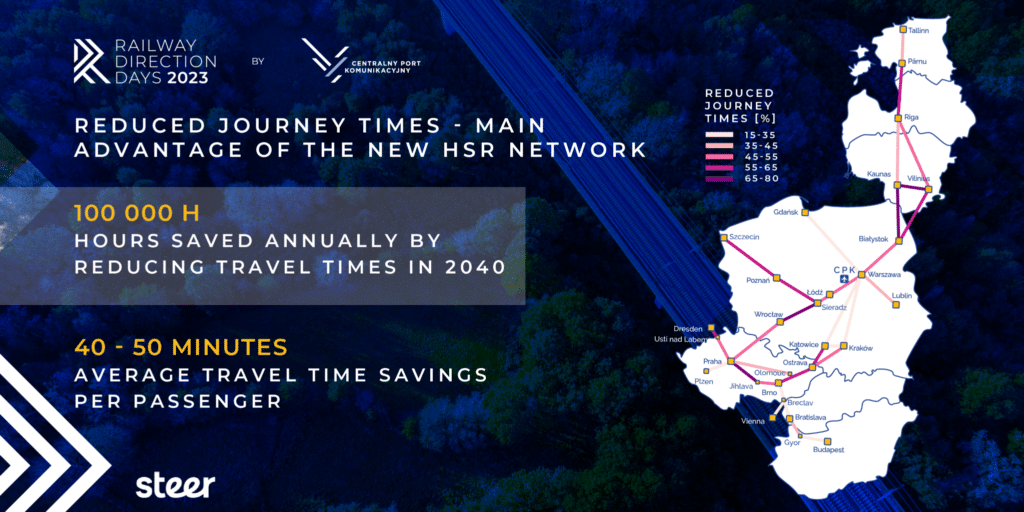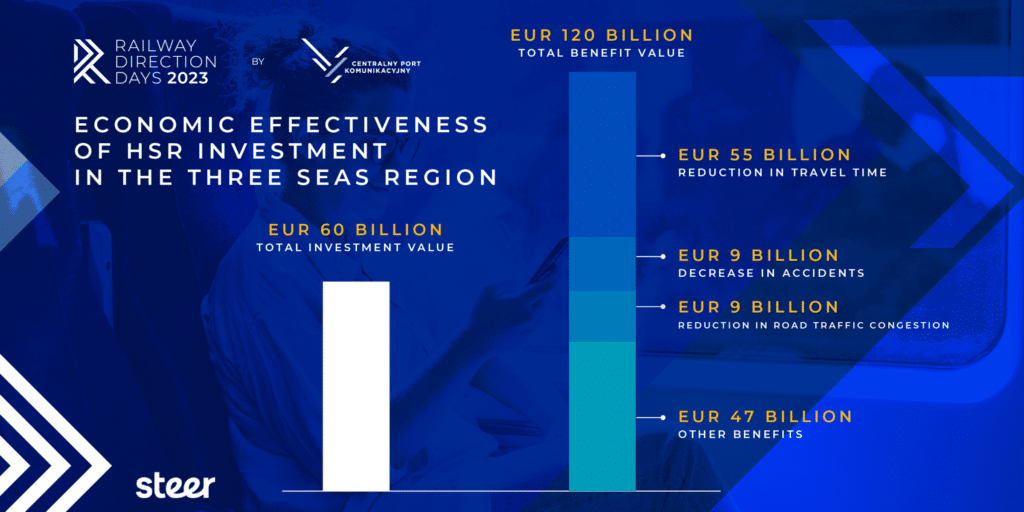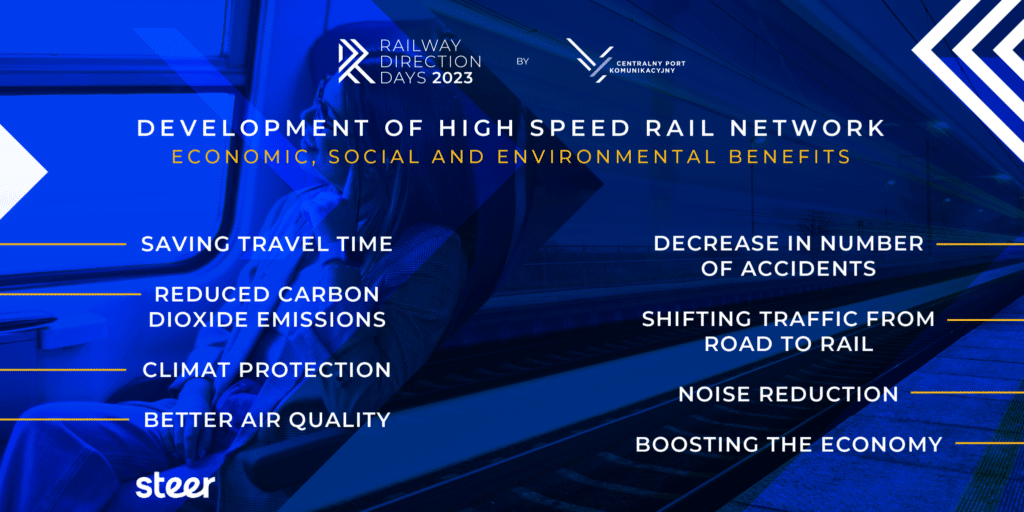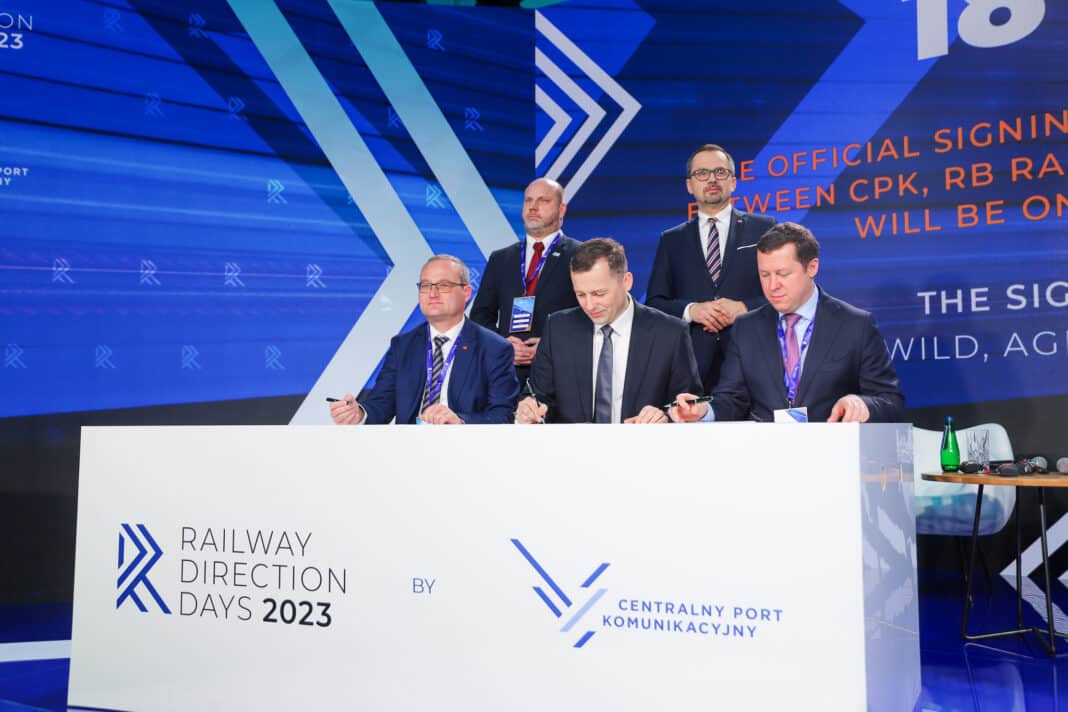Almost 4,500 km of High Speed Railway lines are planned for the Three Seas Region. The first sections should be launched as early as 2028. During Railway Direction Days in Warsaw, a cooperation agreement was signed by representatives of Centralny Port Komunikacyjny, Rail Baltica and Správa železnic.
According to the investor schedules, by 2028, the time of the planned launch of the first stage of the CPK airport, the first section of the Warsaw – Łódź HSR being planned by CPK should already be operational, as well as the completion of modernization of the Rail Baltica route by PKP PLK from the Lithuanian border via Białystok to Warsaw.

According to the plan, by 2030 the whole Rail Baltica cross-border corridor should be completed in Estonia, Latvia and Lithuania: from Tallinn via Riga and Kaunas (with a connection to Vilnius) to the Polish border. The first sections of Rail Baltica railway lines are planned to be launched in 2027. The assumption is that the section of the V4 HSR line between Prague, Brno, Bratislava and Budapest will also be built at this time. In the following years, subsequent sections from Poland will be connected to the V4 railway line: Katowice-Ostrava and the so-called Małopolska-Silesian Node.
“The Three Seas Region is one of the fastest growing areas in Europe. Over the past 20 years, the region’s GDP has grown almost twice as fast as the ‘original EU.‘ These rail projects are tailored to the needs of individual countries and the Three Seas region as a whole. The new HSR network, which is the CPK railway investment, together with other projects in the region such as Rail Baltica and V4, will form the future railway backbone of the Three Seas Region and an important part of European TEN-T transport network,” said Marcin Horała, the Deputy Minister for Funds and Regional Policy, the Government Plenipotentiary for CPK.
Thanks to joint investments, there will be a Tallinn – Warsaw – Katowice – Budapest connection (1,700 km) as well as Tallinn – Warsaw – Wrocław – Prague (1,500 km, including 400 km along CPK).
“This is the unique, one-of-a-kind time in our common history when, functioning together in the region, we can create an unrivaled rail transportation offering. We are drawing lessons from HSR investments in the West. As a result, our projects can bring about an economic domino effect, giving a boost to other industries and sectors,” said Mikołaj Wild, CEO of CPK.
“Considering the scale and impact of the Rail Baltica Global project not only in the Baltic states, but also the whole of Europe, we must recognize the benefits and use the full potential from strengthening cooperation with other megaprojects. We have already made significant progress by establishing regular cooperation formats with Centralny Port Komunikacyjny, and will be honored to now extend cooperation also with the national railway infrastructure manager in the Czech Republic.” Agnis Driksna, CEO of RB RAIL AS.
“The cooperation between railway infrastructure managers in the region is viewed by Správa železnic as a cornerstone for future rapid development in the 3 Seas area. Faster travel between hubs, better service quality to passengers, improved safety as well as alleviating capacity on conventional rail for freight seem to be the major benefits that will boost economic growth and multilateral relationships across the region. Given the long-term nature of these projects we understand we must not miss this crucial momentum to invest now in the future, as the positive benefits will be enormous not only for our countries but also for the whole of Europe,” said Radek Čech, director of international affairs at Správa železnic.
The project organizations have the support of international allies, who point out that the planned infrastructure will be dual-use, that is civil-military.
“Current events have shown that reliable and resilient rail infrastructure is so incredibly important for the safety and security of the region. An investment in this infrastructure is an investment into the long-term security of the region. It is just as important as our collaboration on national security, energy security, and defense,” said Mark Brzezinski, the US ambassador to Poland.
“Rail Baltica and the CPK railway projects are important to integrate the region more closely into the EU’s transport network and achieve environmental benefits by shifting traffic to rail,” according to Catherine Trautmann, European coordinator of the NSB Corridor.
The planned HSR system in the Three Seas Region area will be cost-effective, according to a report presented at Railway Direction Days by Steer, an international consultancy which performs analyses for the European Commission.

The estimated total cost of the entire HSR network in the Three Seas Region is around €60 billion. The authors of the report estimated that the total value of the benefits in the HSR network for the Three Seas Region countries would be more than €120 billion. According to Steer’s calculations, €55 billion represent passenger journey time savings and €57 billion are the other benefits of the project, including those resulting from a decrease in transportat accidents.
The good news for passengers is that there will be significant shortening of travel times, such as on the Łódź – Wrocław section, where the journey will be shortened from 3 hours to about 1 hour. From Warsaw, traveling to Vilnius will take 4 hours (currently 9 hours), to Riga 5 hours (today there is no such direct connection by train, and the travel time by bus takes more than 8 hours), to Ostrava less than 2 hours (currently 4.5 hours) and to Budapest 5.5 hours (currently 11.5 hours).
It will take approximately two hours to get from Prague to Vienna and Bratislava (currently close to 4.5 hours), while the journey to Budapest from the Czech capital will be reduced to 3.5 hours (from the current 7 hours). From Vilnius passengers will reach Tallinn in approximately 3.5 hours (currently it takes more than 8 hours), and Riga will be reached in less than 2 hours (from the current over 4 hours).
According to Steer’s calculations, the busiest sections will be Warsaw – Łódź in Poland, Brno – Jihlava in the Czech Republic and Budapest – Gyor in Hungary. Each will carry between 14 and 18 million passengers a year.
Planning and design work is well advanced. For example in Poland feasibility studies are already being developed for 1,500 km of the 2,000 km planned CPK so-called spokes, including a 140 km section of the HSR between Warsaw and Łódź (the preparatory construction work should start in the second half of this year) and a 200 km section between Łódź and Wrocław.

In the Baltics more than 640 km out of 870 km total corridor is under design and large-scale constructions are approaching. In Latvia, a tender for construction works for a 200 km section of the Rail Baltica railway line is underway, and RB Rail AS has launched an electrification subsystem design and build tender for the electrification of the entire 870 km Rail Baltica network. Meanwhile the Czech Republic is preparing design documentation for, among other things, the section between Ostrava and Przerov.
Ultimately, the HSR rail system will be able to cover all the Three Seas Region countries and be ready for further development within Ukraine (extension of the CPK’s ‘spoke’ no. 5 to Lviv and ultimately to Kiev). The development of the Poland-Ukraine HSR connection is part of the reconstruction plan for the country and the concept of extending the TEN-T corridors beyond Poland’s eastern border.

